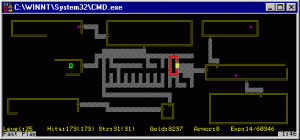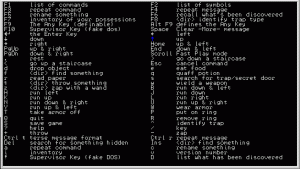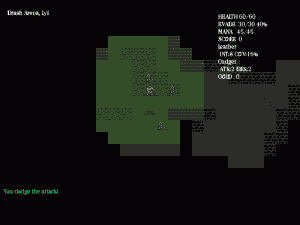Once every so often I get asked what a roguelike is. Usually this is the direct result of discussing a particular game with someone and the recipient not having a clue what I am talking about. Since Mana Pool has a very strong focus on both Indie games and RPGs in particular, we thought it was about time that we explain what a roguelike is, and where they came from!
What is a Roguelike?
The term roguelike applies to a sub-genre of the RPG, and usually involves dungeon crawlers in one form or another. Common features of roguelikes include; permanent death, turn-based movement, randomisation and dungeon exploration.
Most roguelikes involve encounting dozens, if not hundreds, of monsters and items. Items are usually found in an unidentified state, meaning the player only knows a very small portion of the items characteristics. Identifying items is a common goal in these games and is usually accomplished by scrolls, spells and ‘gut feeling’. (“You feel the <item> you are carrying is very special…”)
The turn-based element of roguelikes is handled a little differently than modern gamers are generally used to. Every time the player takes a step – the game processes a turn, and ensures monsters and the environment do their thing. (E.g. a monster might take a step or attack, poison might tick, your lamp uses a turn of fuel, etc.)
Origin of Roguelikes
The origin of roguelikes is quite interesting, and one that is easy to remember. The first true roguelike was released in 1980 under the name ‘Rogue’, so the genre is literally called ‘like rogue’.
Rogue was based on Dungeons & Dragons, a paper & pencil based role-playing game that experienced great popularity. Rogue used D&D concepts such as stats and experience points, which is common now but back then was a fairly new concept to video games.
ASCII vs Graphical Tilesets
The first roguelikes started with ASCII graphics, where the “A” symbol would usually represent the player character. Letters of the alphabet are used to represent monsters and other characters. Rogue only used capital letters, but most modern roguelikes use capitalization to increase the number of different creatures in the game.
Additionally, different colours can be used to make a distinction between different creatures. For example, a blue “D” might be a Blue Dragon, and a red “D” a Red Dragon. Full stops are usually reserved to show the floor – with yellow full stops showing ‘lit areas’. (Giving a visual clue on the range of your torch) “#” usually represents a wall, and “|” and “-“ are walls.
We’ve since come a long way and most roguelikes have graphical tilesets available, making it far easier for the less hardcore players to actually play the games.
New roguelikes even develop a graphical user interface, a step away from the classic “use every single key on the keyboard” control schemes.
Historically, players issuedgame commands with at most a few keystrokes, rather than with sentences interpreted by a parser or by means of a pointing device such as a mouse.
For example, in NetHack one would press “r” to read a scroll, “d” to drop an item, and “q” to quaff (drink) a potion.
The best friend of a roguelike player is therefore the invention of macros, enabling players to ‘hotkey’ certain spells and reduce the risk of RSI.
Notable Roguelikes
There have been far too many roguelikes to list them all, so we will list the ones that we feel have been influential on the PC.
The format of this list in order is: Release year, last supported/updated, and name of the Roguelike. Click on the name to go to a website where the game can be downloaded and played. All of the linked games can be downloaded and played for free. Bear in mind that newer games generally look a little more acceptable to new players to the genre.
- 1980 – Rogue
- 1982 – Hack
- 1983-1999 – Moria
- 1987-2003 – Nethack
- 1989 – Castle of the Winds
- 1990-2009 – Angband
- 2002-2010 – Tales of Middle Earth
- 1994-2002 – Ancient Domains of Mystery
- 1997-2005 – Linley’s Dungeon Crawl
- 2006-2010 – Stone Soup
- 2006-2010 – Dwarf Fortress
If you are interesting in playing a Roguelike, most people would recommend Stone Soup, which is a fork of Linley’s Dungeon Crawl. ADoM is regarded as very good but also devilishly hard and really intended for more experienced players. I personally have had very good experiences with ToME – a fork of Angband.
Dwarf Fortress is in a class of its own. It’s an absolutely freaking awesome game where you can either play in a more classic Roguelike manner as an adventurer – or manage an entire population of Dwarves. The latter mode is both awesome and at the same time one of the most in-depth and complex gaming experiences you will ever have. Steep learning curve does not even begin to describe it – without following some tutorials on YouTube, you will simply not be able to play.
That concludes our guide to roguelikes – hopefully you now understand what a roguelike is, and where you can find, download, and play some of the more notable ones.



As addition to the above – if you want an easy entry into roguelikes, Dungeons of Dredmor on Steam is a rather succesful attempt at making roguelikes more accessible. Highly recommended.
ADoM is has recently been brought back to life (ie. Being updated/supported)
Love your writing, by the way